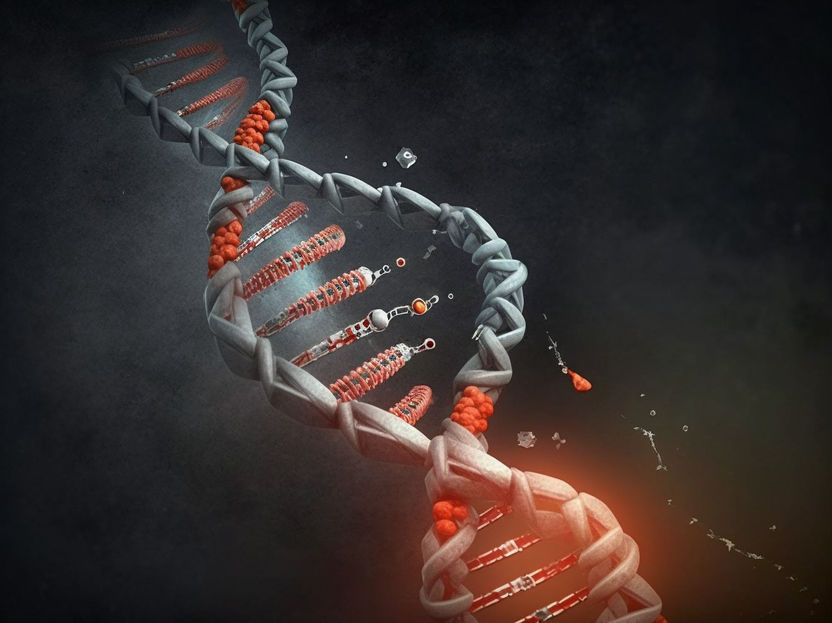Hidden RNA repair mechanism discovered in humans
Function of a previously uncharacterized human protein elucidated
Konstanz researchers discover the function of a previously unexplored protein: In three characteristic steps, "C12orf29" links the ends of RNA strands. Proteins that perform this kind of RNA ligation were previously unknown in humans. The results of the study suggest that it is important for RNA repair during cellular stress.

Symbolic image
Computer-generated image
Ribonucleic acids (RNAs) are single-stranded molecules that play an essential role in the cells of all living organisms. As "transcripts" of our genes, mRNAs, for example, are involved in the translation of genetic information by carrying in their own sequence the instructions for the creation of a protein. "In order to fulfil their diverse functions in the cell, RNAs often need to be chemically modified after their creation or repaired after damage," explains Andreas Marx, professor of organic and cellular chemistry at the University of Konstanz.
One chemical reaction that plays a role here is the three-step linking (ligation) of two RNA strands at their respective opposite ends. This reaction is triggered by specialized enzymes called RNA ligases and is present in all forms of life, from viruses to fungi and plants. In vertebrates, including humans, such RNA ligases had yet to be identified. An interdisciplinary research team from Konstanz has now discovered the first human RNA ligase of this type, the protein C12orf29. At the cellular level, the study results, published in Nature Communications, suggest a protective function of the enzyme against cellular stress.
Antioxidant defence system of our cells
"We noticed C12orf29 during extensive studies of human lung carcinoma and kidney cells that we performed in search of proteins with a specific chemical signature and for which we used new chemical tools. It caught our attention because until then it was not understood what the protein's functions were," Marx says. The researchers therefore developed and used various protocols to purify and predict the structure of the unexplored protein and performed experiments to track down its chemical function. They were thus able to prove what was initially only a reasonable suspicion: C12orf29 links RNA strands using adenosine triphosphate (ATP).
The researchers were able to show in detail that this process follows a characteristic, three-step reaction pattern known from other RNA ligases of other life forms. To learn more about the function of C12orf29 at the cellular level, the researchers went one step further after elucidating the chemical mechanism. "We used the CRISPR/Cas gene scissors to generate a line of human kidney cells in which the gene encoding C12orf29 was knocked out. We were then able to compare these knockout (KO) cells with 'normal' kidney cells under varying experimental conditions," Marx explains.
In particular, when treating the cells with menadione, a K vitamin, clear differences were observed between KO cells and the wild-type cells with functional RNA ligase: Comparatively low concentrations of menadione were sufficient to damage KO cells. In contrast, the wild-type cells were only damaged at significantly higher concentrations. Since menadione is known to cause oxidative stress, the researchers concluded from this result that C12orf29 protects against oxidative cellular stress. "We assume that a previously hidden human RNA repair mechanism underlies this biological function of C12orf29. We now need to examine this mechanism in further studies," Marx says.
Original publication
Other news from the department science

Get the analytics and lab tech industry in your inbox
By submitting this form you agree that LUMITOS AG will send you the newsletter(s) selected above by email. Your data will not be passed on to third parties. Your data will be stored and processed in accordance with our data protection regulations. LUMITOS may contact you by email for the purpose of advertising or market and opinion surveys. You can revoke your consent at any time without giving reasons to LUMITOS AG, Ernst-Augustin-Str. 2, 12489 Berlin, Germany or by e-mail at revoke@lumitos.com with effect for the future. In addition, each email contains a link to unsubscribe from the corresponding newsletter.


















































